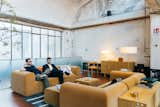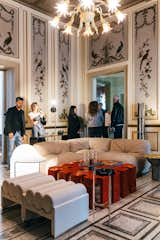If you had just one day at design week in Milan, how would you spend it? That’s the question I posed to myself when I landed in the city for its 63rd edition. The answer turned out to be: See 11 exhibitions, attend two dinners, shake upwards of 50 hands, take more than 1,100 photos, and set a new personal record for most steps taken in a day at 23,532 (Take that, Duncan Nielsen!)
Between a room made entirely from cork, a maze wrapped in faux fur, and a decrepit space with loose floorboards underfoot, photographer Olga Mai and I were able to cover a lot of ground—more than eight miles worth. Here’s everything we saw on Thursday last week as we zigzagged across Milan.
Nilufar Depot (10:00-10:40)
On Thursday morning, we were off to a late start because someone
missed the train. But I was able to catch up with Olga around 10:20 just outside of Nilufar Depot, a Milanese gallery and staple of Milan Design Week that’s known for its juxtapositions of older icons and newer designs. To celebrate the 10th anniversary of the depot (Nilufar Gallery proper has been around since 1979), Nilufar designed its presentation to function as something of a walking theater, unfolding as five acts across its three floors. When walking through the space, it almost felt like exploring an impeccably curated vintage store, as familiar floor lamps, tables, and chairs stood against brand new designs. The effect was a fantastic tasting menu of where we’ve come from in furniture design, and where we might be headed.
Upon entering the space, we were greeted by a fur-lined maze with an emphasis on metal furniture, all co-curated by Fosbury Architecture. Within it, corners were populated by well-known works like Mario Bellini’s Chiara floor lamp and contemporary counterparts like Studioutte’s Armadillo Low table, both shown above.
Casa Cork by David Rockwell (10:40-11:20)
The exhibition on the lips of many people I spoke with was Casa Cork, an immersive installation by the Cork Collective that reused natural cork stoppers. Located in a cavernous space within the Porta Garibaldi neighborhood, the installation comprised cork furnishings by a group of designers, from wall sconces to lounge chairs to bartenders’ aprons. Personally, I’ve been a longtime fan of Noé Duchaufour-Lawrance’s “Made in Situ chair,” which binds particles of cork into the shape of a curvilinear seat, but the space was full of new discoveries that, to someone unfamiliar with cork’s malleable properties, are close to mind-blowing. The lasting message is a decree on the flexibility of one of the design world’s most regenerative materials.
SCP (11:20-12:00)
To celebrate its 40th anniversary, British manufacturer SCP divided its Milan showroom into three sections: the first highlighted George Sowden’s rubberized lighting designs; the second presented SCP’s 2025 collection of new upholstered seating, all while outlining the company’s commitment to furniture free from common petrochemical-based-foam; the third was the Boxed collection, which exhibits the work of a group of designers tasked with creating objects—from tables to wall hooks—that fit into a shipping container. As a Sowden fan, I was thrilled to see the full collection, pulled together by a Mondrian-esque mural. And as someone passionate about sustainable innovation, I found that SCP went beyond lip service and actually identified where the furniture industry can be efficient, responsible, and stylish.
Ligne Roset (12:00-12:40)
When so much of the city seems to be searching for the next big thing, established brands have the unique opportunity to revive something from the past. For design week, Ligne Roset reissued the Sandra settee and Kashima armchair from the ’70s and ’80s, and they both feel perfectly contemporary without leaning too experimental. Available in new colors, the seats are about as comfortable as they come, and a reminder of why Ligne Roset has the legacy it does.
Loewe (12:40-13:20)
Loewe has been having a big moment—or several moments—for a few years now. And perhaps the secret to the clothing brand’s success, along with Jonathan Anderson’s contributions as its former creative director, are its commitment to craft and to doing the weird thing. In Milan, the brand worked with artists, designers, and architects from around the world to create 25 teapots that contextualize a new selection of homewares from the brand, from coasters to tea cozies to leather charms. For the main event, each designer took the familiar, utilitarian form of the teapot and translated it into a work of art. Laid out on a simple, long tabletop in a bunker-esque space at the back of Palazzo Citterio, a museum in the city, it was a dramatic-enough presentation from one of the only fashion brands that, from this writer’s POV, deserves a seat at the table at the world’s biggest furniture fair.
Marimekko (13:20-14:00)
This year, Marimekko joined forces with Laila Gohar, an Egyptian-American artist known best for her tableware brand Gohar World. The collaboration led to a new line of bedding, sleepware, and ceramics in a trendy range of colorful stripes that Gohar pulled from the Marimekko archive, from tangerines and aquas to maroons and baby blues. When I chatted with Gohar, she explained that the collection is based on her own philosophy of how to use your bed, which, according to her, is for everything. To emphasize that idea—and reference Gohar’s background in food arts—the Marimekko team focused on one of the most agreed-upon bedroom faux-pas: eating there. Not pictured here is the twin mattress made entirely of cake decorated to match the room. I attended the cake cutting the day prior to this, and, while it looked better than it tasted, it sure was a fun moment for a brand that’s so resonant with home life and keep-sakes. It also didn’t hurt that it was my birthday, so midday cake was welcome.
Beni Rugs (14:00-14:40)
Beni Rugs, helmed by artistic director and interior stylist Colin King, is a seven-year-old brand that works with Moroccan artisans to produce rugs that combine traditional craft with distinctive and daring themes. This year, they worked with Studio KO, a Parisian architecture firm, to produce Intersection, a line of 10 new rugs that exhibit five weaving techniques. For the collection, the designers chose to highlight the narrative ability of paperwork—paired with rugs’ historic propensity for storytelling—to transform potentially the most boring inspiration into a genuinely exciting range of floor coverings. I particularly enjoy how they translated perforated lines and graph sheets.
Ikea (14:40-15:20)
Like Ligne Roset, Ikea took a look back at its heavy hitters, reviving one of its most popular lines: the Stockholm collection. It features some of the company’s higher-end pieces, so while the prices are a bit more than you would usually expect from the mass-producer, I fear the furniture might be worth it. The best things I saw were all tan, but their forms and textures were impressive.
Calico Wallpaper (15:20-16:00)
Using the Instituto dei Ciechi in Porta Monforte as a frame, Calico displayed its most recent design, Particulaire, which came from a collaboration with American design studio Stephen Burks Man Made. The wallpaper, which comes in five colorways, outlines Malika Leiper and Stephen Burks’s favorite objects they’ve accrued during their travels. And while it might seem a bit introspective for a product intended for someone else’s home, there’s something about the wall covering that feels like a meeting place for a diverse group of people who might be able to see themselves represented in the highlighted objects. The pieces shown range from quotidian tools to pleasant decorations, but their silhouettes take on more artistic meaning when thrown into relief against the institute’s walls.
L’Appartamento by Artemest (16:40-17:20)
Since being founded 10 years ago, furniture brand Artemest has prided itself on showcasing Italian craftsmanship. For its anniversary, it took buyers a step further into Italian design by opening up the doors to Palazzo Donizetti, which has never been open to the public, for its third edition of L’Appartamento by Artemest. This year’s exhibition featured 180 Italian artisans and artists, and is divided into six unique spaces, each curated by a different interior design studio.
After climbing up a dramatic elliptical staircase, guests entered the first room of the tour, The Foyer, curated by Simone Haag. Of the entire exhibition, the pieces shown here seemed to be the most radical, and their contrast against the Italianate setting was superb. The floor lamp was my favorite piece.
Hem & USM at Capsule Plaza (17:20-18:00)
Each year, Capsule Plaza maintains as somewhat of a cool-kid meetup of brands in the design world. This year, Stockholm brand Hem celebrated its 10-year anniversary in an immersive suite along one wall of the square. Delineated by increasingly trendy wall-to-wall carpet, the experience opened with an elongated pedestal that ran the length of the room, elevating 17 of the brand’s most beloved collaborations over the years. Next, two rooms appeared, each with an office-chic aesthetic sensibility, complete with glass walls, fluorescent overheads, and filing materials. The backdrop worked extremely well against Yrjö Kukkapuro’s Experiment lounge chairs and Hem’s newest release, a bed-like modular sofa by Philippe Malouin called the Great sofa.
On the other side of the plaza, USM’s modular shelving provided a backdrop for Pharrell’s skincare brand, Humanrace. The installation of metal sheets was impressive, dissolving what we usually see from the brand and rebuilding it as a dream bathroom fit for any proper modernist.




















































